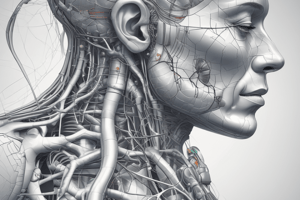Podcast
Questions and Answers
What is the primary function of the nasal hairs in the respiratory system?
What is the primary function of the nasal hairs in the respiratory system?
- To filter the air entering the nares (correct)
- To provide structural support
- To assist in speech
- To produce mucus
Which structure serves as a passageway for both air and food?
Which structure serves as a passageway for both air and food?
- Bronchi
- Pharynx (correct)
- Trachea
- Larynx
What distinguishes the left lung from the right lung?
What distinguishes the left lung from the right lung?
- The left lung has three lobes
- The left lung is larger and heavier
- The left lung does not perform gas exchange
- The left lung is smaller and has two lobes (correct)
What is the role of pleural fluid in the respiratory system?
What is the role of pleural fluid in the respiratory system?
Which part of the respiratory system is primarily responsible for the exchange of oxygen and carbon dioxide?
Which part of the respiratory system is primarily responsible for the exchange of oxygen and carbon dioxide?
Why do the right and left primary bronchi differ in structure?
Why do the right and left primary bronchi differ in structure?
Which of the following is NOT a component of the upper respiratory system?
Which of the following is NOT a component of the upper respiratory system?
What is the significance of the C-shaped rings of cartilage in the trachea?
What is the significance of the C-shaped rings of cartilage in the trachea?
What is the tidal volume (TV) in a healthy individual?
What is the tidal volume (TV) in a healthy individual?
Which volume represents the total air that can be exhaled after a maximal inspiration?
Which volume represents the total air that can be exhaled after a maximal inspiration?
What is the approximate amount of air for residual volume (RV) in the lungs after forced expiration?
What is the approximate amount of air for residual volume (RV) in the lungs after forced expiration?
What is the primary purpose of surfactant in the alveoli?
What is the primary purpose of surfactant in the alveoli?
Which pressures are necessary for expanding and contracting the lungs?
Which pressures are necessary for expanding and contracting the lungs?
What factor mainly affects lung compliance?
What factor mainly affects lung compliance?
What condition could increase respiratory passageway resistance?
What condition could increase respiratory passageway resistance?
What is the approximate total vital capacity for a healthy individual?
What is the approximate total vital capacity for a healthy individual?
Flashcards are hidden until you start studying
Study Notes
Upper Respiratory System
- Nose: External opening; divided into two cavities (nostrils) by the nasal septum, containing hair follicles, sweat, and sebaceous glands that filter air.
- Sinuses: Located in frontal, ethmoid, sphenoid, and maxillary bones; lighten skull, assist in speech, and produce mucus for debris trapping.
- Pharynx: Funnel-shaped tube about 5 inches (13 cm) long; serves both air and food passage.
- Larynx: Approximately 2 inches (5 cm) long; channels air and food into the appropriate pathways.
- Trachea: Ranges from 4-5 inches (12-15 cm) long and 1 inch in diameter; comprises 16-20 C-shaped cartilage rings connected by tissue.
- Respiratory Passages: Include nasal cavity, pharynx, larynx, trachea, and bronchi; facilitate air movement into lungs and food transfer to the esophagus.
Lower Respiratory System
- Lungs: Comprised of elastic connective tissue (stroma); left lung has 2 lobes, right lung has 3. Pulmonary arteries bring deoxygenated blood to lungs; pulmonary veins carry oxygenated blood to the heart.
- Pleura: Double-layered membrane enveloping lungs and thoracic cavity; produces pleural fluid to reduce friction during breathing.
- Bronchi: Divide into right/left primary bronchi, secondary (lobar), tertiary (segmental) bronchi, and bronchioles, collectively forming the bronchial tree. The right primary bronchus is shorter and wider.
- Alveoli: Functional units of lungs; ~300 million in adults where gas exchange occurs, clustered around alveolar sacs.
Factors Affecting Ventilation and Respiration
-
Changes in Respiratory Volume and Capacity:
- Tidal Volume (TV): Amount of air (approx. 500 mL) inhaled/exhaled in normal breath.
- Inspiratory Reserve Volume (IRV): Additional air (2100-3100 mL) that can be forcibly inhaled.
- Expiratory Reserve Volume (ERV): Air (approx. 1000 mL) that can be forcibly exhaled.
- Residual Volume (RV): Air (approx. 1100 mL) remaining in lungs post-expiration.
- Vital Capacity (VC): Total exhaled air post-maximal inhalation, calculated from IRV, TV, and ERV (approx. 4500 mL).
- Anatomic dead space volume is about 150 mL of air that doesn't reach alveoli.
-
Gas Concentrations: Respiratory centers and chemoreceptors react to levels of O2, CO2, and hydrogen ions.
-
Airway Resistance and Lung Compliance:
- Resistance from friction in airway passageways, constriction, mucus accumulation, or tumors.
- Lung compliance indicates the lungs' stretchability, influenced by lung elasticity and rib cage flexibility.
-
Alveolar Surface Tension: Molecules at gas-liquid boundaries are more attracted to each other, creating surface tension. Surfactant reduces this tension, aiding lung expansion.
-
Air Pressures:
- Intrapulmonary Pressure: Fluctuates within alveoli during ventilation.
- Intrapleural Pressure: Lower than intrapulmonary pressure; also varies with ventilation.
- During inspiration, lung expansion lowers intrapulmonary pressure, causing air to flow in.
Studying That Suits You
Use AI to generate personalized quizzes and flashcards to suit your learning preferences.





